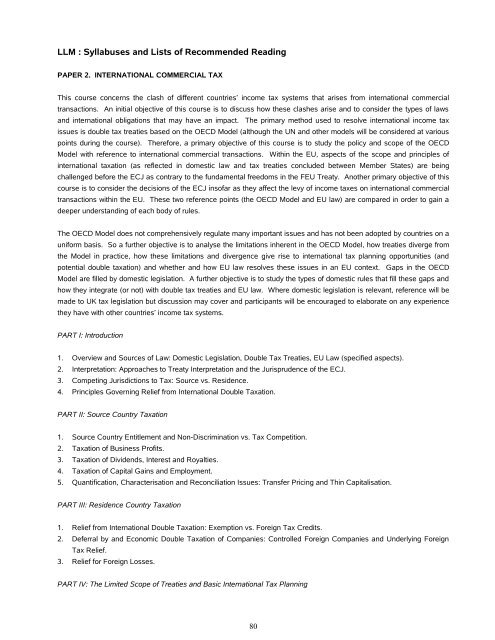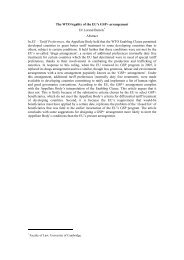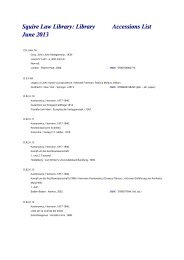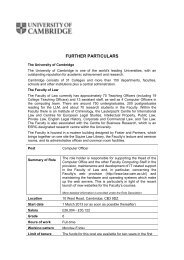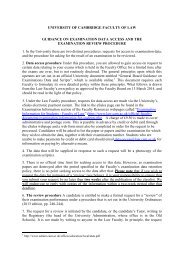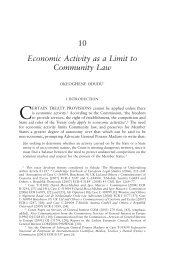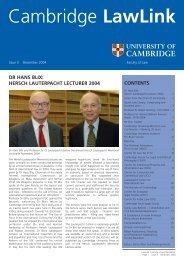Contents - Faculty of Law - University of Cambridge
Contents - Faculty of Law - University of Cambridge
Contents - Faculty of Law - University of Cambridge
Create successful ePaper yourself
Turn your PDF publications into a flip-book with our unique Google optimized e-Paper software.
LLM : Syllabuses and Lists <strong>of</strong> Recommended ReadingPAPER 2. INTERNATIONAL COMMERCIAL TAXThis course concerns the clash <strong>of</strong> different countries’ income tax systems that arises from international commercialtransactions. An initial objective <strong>of</strong> this course is to discuss how these clashes arise and to consider the types <strong>of</strong> lawsand international obligations that may have an impact. The primary method used to resolve international income taxissues is double tax treaties based on the OECD Model (although the UN and other models will be considered at variouspoints during the course). Therefore, a primary objective <strong>of</strong> this course is to study the policy and scope <strong>of</strong> the OECDModel with reference to international commercial transactions. Within the EU, aspects <strong>of</strong> the scope and principles <strong>of</strong>international taxation (as reflected in domestic law and tax treaties concluded between Member States) are beingchallenged before the ECJ as contrary to the fundamental freedoms in the FEU Treaty. Another primary objective <strong>of</strong> thiscourse is to consider the decisions <strong>of</strong> the ECJ ins<strong>of</strong>ar as they affect the levy <strong>of</strong> income taxes on international commercialtransactions within the EU. These two reference points (the OECD Model and EU law) are compared in order to gain adeeper understanding <strong>of</strong> each body <strong>of</strong> rules.The OECD Model does not comprehensively regulate many important issues and has not been adopted by countries on auniform basis. So a further objective is to analyse the limitations inherent in the OECD Model, how treaties diverge fromthe Model in practice, how these limitations and divergence give rise to international tax planning opportunities (andpotential double taxation) and whether and how EU law resolves these issues in an EU context. Gaps in the OECDModel are filled by domestic legislation. A further objective is to study the types <strong>of</strong> domestic rules that fill these gaps andhow they integrate (or not) with double tax treaties and EU law. Where domestic legislation is relevant, reference will bemade to UK tax legislation but discussion may cover and participants will be encouraged to elaborate on any experiencethey have with other countries’ income tax systems.PART I: Introduction1. Overview and Sources <strong>of</strong> <strong>Law</strong>: Domestic Legislation, Double Tax Treaties, EU <strong>Law</strong> (specified aspects).2. Interpretation: Approaches to Treaty Interpretation and the Jurisprudence <strong>of</strong> the ECJ.3. Competing Jurisdictions to Tax: Source vs. Residence.4. Principles Governing Relief from International Double Taxation.PART II: Source Country Taxation1. Source Country Entitlement and Non-Discrimination vs. Tax Competition.2. Taxation <strong>of</strong> Business Pr<strong>of</strong>its.3. Taxation <strong>of</strong> Dividends, Interest and Royalties.4. Taxation <strong>of</strong> Capital Gains and Employment.5. Quantification, Characterisation and Reconciliation Issues: Transfer Pricing and Thin Capitalisation.PART III: Residence Country Taxation1. Relief from International Double Taxation: Exemption vs. Foreign Tax Credits.2. Deferral by and Economic Double Taxation <strong>of</strong> Companies: Controlled Foreign Companies and Underlying ForeignTax Relief.3. Relief for Foreign Losses.PART IV: The Limited Scope <strong>of</strong> Treaties and Basic International Tax Planning80


